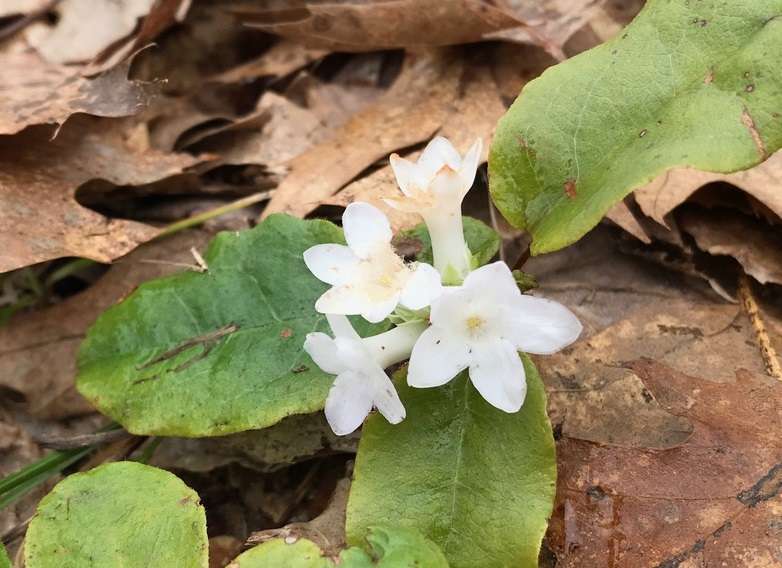Out In the Woods
- May 3rd 2024
- Out in the Woods

A mayflower emerges from last year’s leaves
The Mayflower’s Delicate Scent Still Captivates
Credit: Kevin McKeon
By Kevin McKeon, Mousam Way Land Trust Director
A welcoming spring sight along Sanford’s woodland trails are the paste-pink flowers with shiny, oval, evergreen leaves attached to rust colored, hairy vines, sprawling along the forest floor that belong to the Mayflower, Epigaea repens. True to its name, early spring buds turn into blooming flowers in early May and are an important early-season source of nectar for bumblebees and other early-emerging insects. They also contain arbutin, an antiseptic that the Cherokee, Iroquois, and others used for healing.
This exquisite, sweet-scented woodland flower, also called the Trailing Arbutus, displays its trumpet-shaped blooms in clusters, and its long running stems form a small groundcover in forest openings. The Hoary Elfin butterfly, a delicate, one-inch beauty that’s in serious decline in our area but common in most of its other historical habitats, lays its eggs on the mayflowers, one of only a few plants in the heath family that this little butterfly’s caterpillars can eat.
Mayflowers are a symbol of hope, new beginnings and protection. To the Pilgrims, fleeing the worn-out fields and treeless landscapes of England, the vast, heavily wooded lush forests of New England were a Garden of Eden. The abundant mayflowers were the queen of all the spring-blossoming wildflowers. During the late 1800s, heavy harvesting of these flowers for use in decorative, fragrant displays began to threaten the species’ existence, raising public concern and protection advocacy. Massachusetts politicians lobbied to adopt the mayflower as the state flower. To escape this volatile issue, they deemed that Massachusetts’ children would vote for either the Water Lily or the Mayflower. In 1918, there was a landslide win for the Mayflower. In 1925, it became a $50 fine to “pull up”, “dig up” or “injure” any part of the plant located on public lands. The fine was doubled, “if a person does any of the aforesaid acts while in disguise or secretly in the nighttime” i.e., poaching! The mayflower remains the state flower of Massachusetts and is also provincial flower of Nova Scotia.
Relatively recent agricultural abandonment has allowed fields to revert back to thick, new-growth forests with too much shade for mayflowers to thrive in their original vast numbers. So, look for these ground-loving wildflowers along the sunny sides of woodland trails where leaves get blown away, reducing competition for sun.
Transplanting from the wild is rarely successful, and illegal in some states, due to delicate roots, and sensitivity to disturbances, drought, and heavy rain. Even growing mayflowers from seeds is a challenge as they need almost perfect soil conditions and are slow to germinate. Enjoy it where it lives in acidic, woodsy soil like that found under pine and oak trees. Get down to their level and experience an early spring, delicate fragrance!






